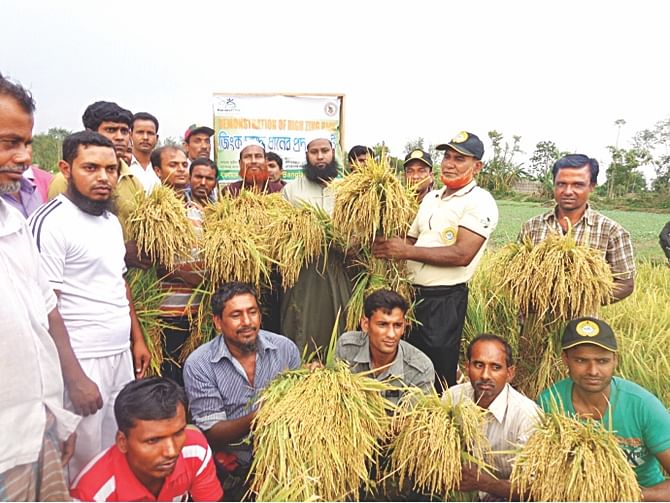Another rice variety ready for release
Another rice variety ready for release

A year after releasing the world's first zinc-enriched rice variety, Bangladeshi breeders have come up with another rice variety with higher zinc content and greater yield potentials.
High-zinc rice -- Brri dhan-62 -- released late last year contains around 19 to 20 parts per million (ppm) zinc against 14 to 16 ppm in other high-yielding rice varieties. However, the ready-for-release rice breed contains zinc as high as 25 ppm.
Zinc, iron and vitamin-A are the three most vital micronutrients, deficiency of which hampers children's natural growth and decrease their disease prevention capacity. In Bangladesh, over 40 percent children under five are stunted while an estimated 44 percent children of the same age group are at risk of zinc deficiency.
Scientists involved in the breeding process confirmed that the latest rice variety is more productive than the high-zinc rice already released. Average yield of Brri dhan-62, meant for rain-fed Aman season, is 4.2 metric tons (MT) per hectare while the proposed hi-zinc line -- Brri dhan-64 -- has yield potentials of over 6 MT per hectare.
The National Seed Board (NSB) is scheduled to consider the release of Brri dhan-64 at its next meeting later this week, sources at the Ministry of Agriculture told The Daily Star.
Both Brri dhan-62 and Brri dhan-64, which are capable of fighting diarrhoea and pneumonia-induced childhood deaths and stunting, have been developed by Bangladesh Rice Research Institute (BRRI) breeders through application of biological fortification (biofortification).
Biofortification is a process, in which plant breeders search for seeds having high nutritional value among existing varieties of crops. They then crossbreed the high-nutrient varieties with high-yielding varieties to provide seeds with high yield and increased nutritional value.
The BRRI breeders developed the high-zinc rice varieties with support from HarvestPlus, a global biofortification mission launched back in 2004 under the Washington-based global agro-science coordinating body Consultative Group for International Agricultural Research.
India lags behind as Bangladeshi breeders have already succeeded in developing two hi-zinc rice varieties -- one (Brri dhan-62) for Aman season and the other (Brri dhan-64) for Boro season.
HarvestPlus Director Howarth E Bouis told The Daily Star that in two years India was expected to come up with some high-zinc rice varieties.
As per the mandate of the international collaboration, the zinc-enriched rice varieties developed in Bangladesh are now expected to reach Cambodia, Indonesia, the Philippines and Vietnam.
Some 27 countries including Bangladesh have so far released different biofortified crops and more are going to join the bandwagon. Some of the other biofortified crops released in other countries include iron-enriched beans and pear millets, zinc-rich wheat and vitamin-A-enriched cassava, maize and sweet potato.
HarvestPlus is spending $10 million for zinc-rice programme between 2013 and 2018, according to Bangladesh Country Manager Md Khairul Bashar.
"We're planning to reach out to half a million households by 2016 with commercialised zinc-rice seeds. The long-term objective is to develop sustainable markets for zinc-enriched seeds and grain, reaching a market share of over three percent of rice by 2018," Bashar said.
Alamgir Hossain, the main BRRI breeder behind the zinc-enriched rice varieties, said that after NSB released the first high-zinc rice last year, the government, NGOs and private seed associations all together supplied over 10,000 farmers with seeds and informed them of the technologies to be used in cultivating crops during the current Aman season.
To assess rice and total dietary zinc intakes in the country, the International Centre for Diarrhoeal Diseases Research, Bangladesh and the University of California, Davis, are collaborating on nutritional research of zinc-enriched rice in Bangladesh.